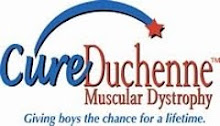Subscribe to:
Post Comments (Atom)
skip to main |
skip to sidebar






Taylor has Duchenne muscular dystrophy (DMD) it's a severe recessive X-linked form of muscular dystrophy characterized by rapid progression of muscle degeneration, eventually leading to loss of ambulation and death. This affliction affects one in 3500 males, making it the most prevalent of muscular dystrophies. In general, only males are afflicted, though females can be carriers. The disorder is caused by a mutation in the gene DMD, located in humans on the X chromosome (Xp21). The DMD gene codes for the protein dystrophin, an important structural component within muscle tissue. Dystrophin provides structural stability to the dystroglycan complex (DGC), located on the cell membrane.
Symptoms usually appear in male children before age 6 and may be visible in early infancy. Progressive proximal muscle weakness of the legs and pelvis associated with a loss of muscle mass is observed first. Eventually this weakness spreads to the arms, neck, and other areas. Early signs may include pseudohypertrophy (enlargement of calf muscles), low endurance, and difficulties in standing unaided or inability to ascend staircases. As the condition progresses, muscle tissue experiences wasting and is eventually replaced by fat and fibrotic tissue (fibrosis). By age 10, braces may be required to aid in walking but most patients are wheelchair dependent by age 12. Later symptoms may include abnormal bone development that lead to skeletal deformities, including curvature of the spine. Due to progressive deterioration of muscle, loss of movement occurs eventually leading to paralysis. Intellectual impairment may or may not be present but if present, does not progressively worsen as the child ages. The average life expectancy for patients afflicted with DMD varies from early teens to age mid 30s. There have been reports of DMD patients surviving past the age of 40 and even 50.


Followers

Blog Archive




3 comments:
We are glad you made it home! Great job, Taylor! You are a superhero!
I just found your blog and became a follower. I found it while doing some research as I prepare to do a blog post about a young man who has Duchenne's for whom I am a caregiver. He has not yet had his spinal surgery as his lungs are not taking in enough air as yet. We are working on that with the spirometer. I am going to pass the link to your blog on to his mother.
Can I ask how old your son is? My client is almost 15. Did your son also have lordosis in addition to the scoliosis?
I hope you don't mind that I am going to use the Cure Duchenne button from your blog to increase awareness. Please let me know if that is not okay.
Thank you for creating this blog about your son. It is very encouraging to see a positive outcome from this very scary surgery.
Kady
Life on the Edge
more blog updates.... ;)
Post a Comment